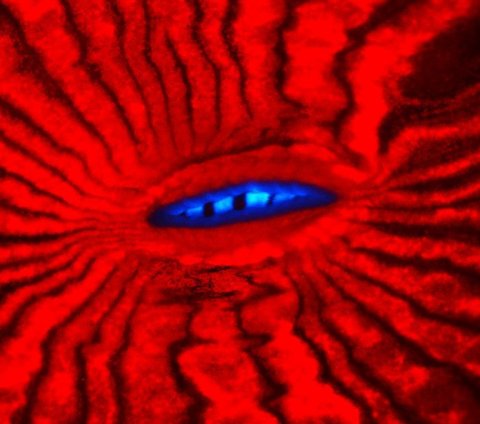Most types of coral depend on the sun to survive, and employ symbiotic algae to churn light into food. This gets more difficult in deep water, and corals that live in these areas have an elegant way of making due with the dimness: They make their own light.
New research shows that many types of coral in deep water can absorb blue light, the wavelength of sunshine that reaches most deeply into the ocean, and re-emit it as a red-orange glow. This is known as fluorescence (which is not the same as bioluminescence, another way that organisms produce light). A paper published in the journal Proceedings of the Royal Society B shows that this red-orange light can penetrate more deeply within the coral than blue light, and helps algae therein to photosynthesize and produce chemical energy. The coral apparently employs this trick to get even more energy out of the little light that reaches the deep sea.
Jörg Wiedenmann, a professor at the University of Southampton, in the U.K., and the study's lead author, first discovered that coral could glow while researching anemones, and was "blown away by a rainbow of colors" while placing corals under ultraviolet light. Subsequent research showed that the chemicals responsible for the light, known as photoconvertible red fluorescent proteins, are present in the surface layer of the coral itself. It was previously thought that the algae themselves were responsible for fluorescence, Wiedenmann says.

The scientists found that 30 percent of corals at a depth of 150 feet at the study site in the Mediterranean had these red fluorescent proteins. The proportion of corals with this "glowing" ability also increases with depth, he adds.
In the paper, the researchers did a long-lasting lab experiment in which they simulated the condition of a deep-sea coral reef. There, they compared the survival rate of different types of coral with and without red fluorescent proteins. They found that over the course of two years, those with the ability to fluoresce had a higher survival rate.
It's unknown as of yet how much light these corals get from fluorescence versus sunlight. However, the benefits appear to be subtle. "It took two years until we could see differences between fluorescent and nonfluorescent [coral] variants in the response to low light levels," Wiedenmann says.
Interestingly, shallow-water coral species also are capable of fluorescing, but for exactly the opposite reason: to protect themselves from too much sunlight. In this case, the role of these light-emitting proteins, also known as pigments, seems to be to absorb some of the light that bombards them daily, and to cast it off in harmless wavelengths.
Coral's "pigments affect a number of functional traits in corals, and [their] ecological importance and function...is therefore diverse," says Michael Kühl, a professor of aquatic microbial ecology at the University of Copenhagen who wasn't involved in the paper. These fluorescing pigments clearly help expand the ecological niches and habitats where coral can thrive, such as in the deep sea, he adds.
The group's work is the subject of an exhibit at London's Royal Society until July 9.















